
Syringa (lilac) is a genus of 12 currently recognized species of flowering woody plants in the olive family (Oleaceae), native to woodland and scrub from southeastern Europe to eastern Asia, and widely and commonly cultivated in temperate areas elsewhere.

Magnolia sieboldii, or Siebold's magnolia, also known as Korean mountain magnolia and Oyama magnolia, is a species of Magnolia native to east Asia in China, Japan, and Korea. It is named after the German doctor Philipp Franz von Siebold (1796–1866).
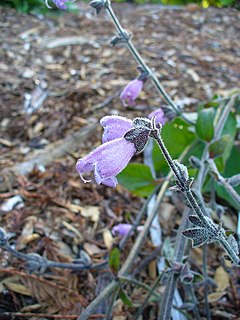
Salvia hians is a mound-forming perennial, native to the Himalayas from Pakistan to Bhutan. It is common in Kashmir, growing at 2,400 to 4,000 m on open slopes and forests. The plant was described in 1830 by John Forbes Royle, a British botanist living in India who studied the medicinal properties of Himalayan plants.

Syringa vulgaris, the lilac or common lilac, is a species of flowering plant in the olive family Oleaceae, native to the Balkan Peninsula, where it grows on rocky hills. Grown for its scented flowers in spring, this large shrub or small tree is widely cultivated and has been naturalized in parts of Europe, Asia and North America. It is not regarded as an aggressive species. It is found in the wild in widely scattered sites, usually in the vicinity of past or present human habitations.

Pachypodium brevicaule is a species of plant that belongs to the family Apocynaceae.
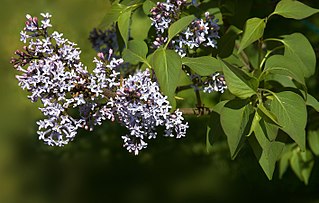
Syringa komarowii is a species of lilac native to central China, commonly called nodding lilac. It is native to the Provinces of Gansu, Hubei, Shaanxi, Sichuan, Yunnan.
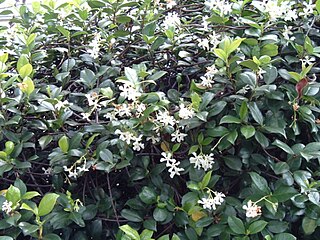
TrachelospermumStar Jasmine, Confederate Jasmine, is a genus of evergreen woody vines in the dogbane family Apocynaceae, first described as a genus in 1851. All species are native to southern and eastern Asia.

Stachys byzantina, the lamb's-ear or woolly hedgenettle, is a species of flowering plant in the mint family Lamiaceae, native to Armenia, Iran, and Turkey. It is cultivated over much of the temperate world as an ornamental plant, and is naturalised in some locations as an escapee from gardens. Plants are very often found under the synonym Stachys lanata or Stachys olympica.

Syringa josikaea, the Hungarian lilac, is a species of lilac, native to central and eastern Europe, in the Carpathian Mountains in Hungary, Romania, and western Ukraine.

Syringa reticulata, the Japanese tree lilac. is a species of flowering plant in the family Oleaceae native to eastern Asia, which is grown as an ornamental in Europe and North America.

Eupatorium japonicum, known as fragrant eupatorium in English and 白头婆 bai tou po, in Chinese, is a herbaceous plant species in Asteraceae. It is native to China, Japan and Korea.
Buddleja yunnanensis is a shrub native to Yunnan and much of the rest of south-western China, where it grows on forest margins, thickets, and along streams at elevations of 1,000 – 2,500 m. The shrub was first described and named by Francois Gagnepain in 1915. This species is distinct from and does not resemble Buddleja nivea var. yunnanensis, although sometimes the latter is erroneously labelled as B. yunnanensis.

Syringa pubescens is a species of flowering plant in the lilac genus of the family Oleaceae, native to Korea and China.

Thymus pulegioides, common names broad-leaved thyme or lemon thyme, is a species of flowering plant in the family Lamiaceae, native to Europe. Growing to 5–25 cm (2–10 in) tall by 25 cm (10 in) wide, it is a small spreading subshrub with strongly aromatic leaves, and lilac pink flowers in early summer. The specific epithet pulegioides highlights its similarity to another species within Lamiaceae, Mentha pulegium (pennyroyal).
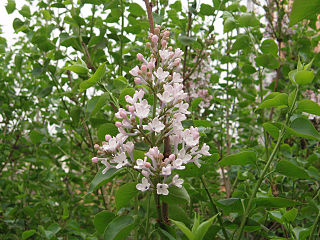
Syringa oblata is a species in the genus Syringa, in the family Oleaceae. It is also known as early blooming lilac or broadleaf lilac.

Syringa emodi is a species in the genus Syringa, in the family Oleaceae. It is also known as Himalayan lilac.
Syringa pinetorum is a species in the genus Syringa, in the family Oleaceae.

Syringa tomentella is a species in the genus Syringa, in the family Oleaceae.
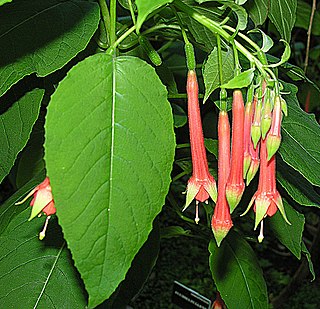
Fuchsia fulgens is a plant of the genus Fuchsia native to Mexico and Central America.
Syringa reticulatasubsp.pekinensis, also known as the Pekin lilac or the Chinese tree lilac, grows in an open, multi-stemmed form to a height of 15 to 20 feet, with a spread of 10 to 15 feet. They are native to northern China but grow in USDA hardiness zones 3 through 7. It is grown as an ornamental tree in Europe and North America.

















